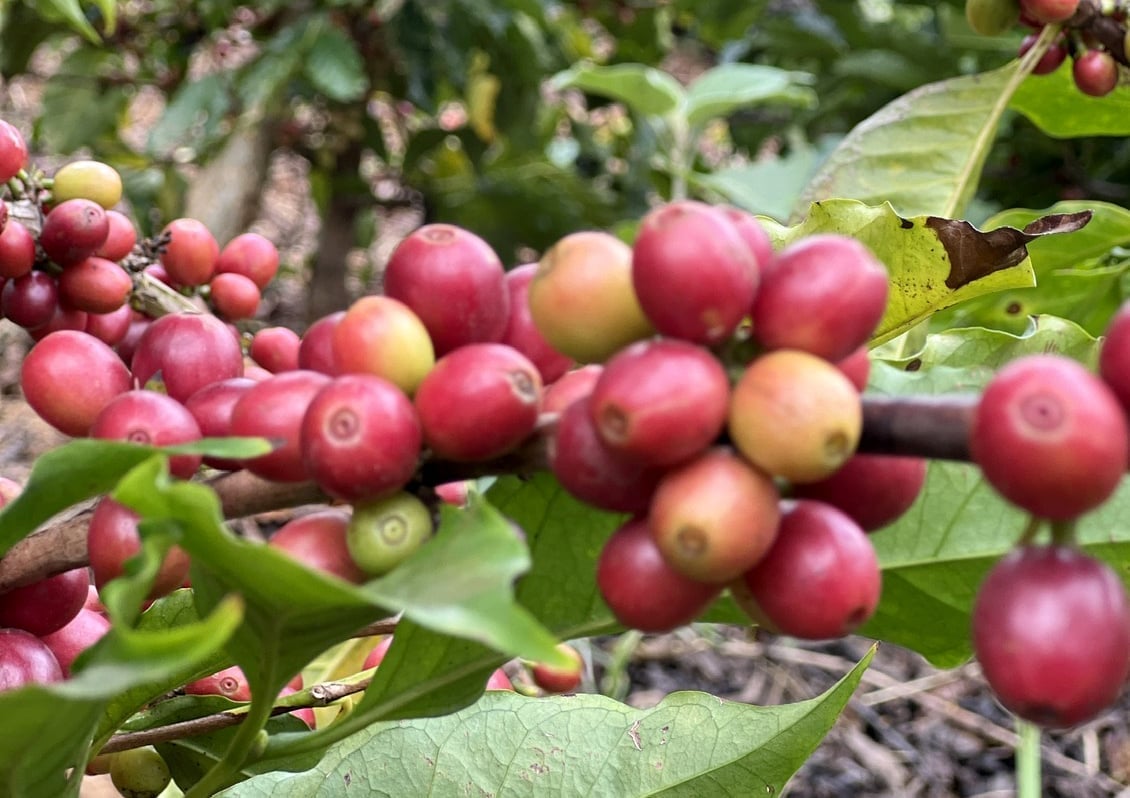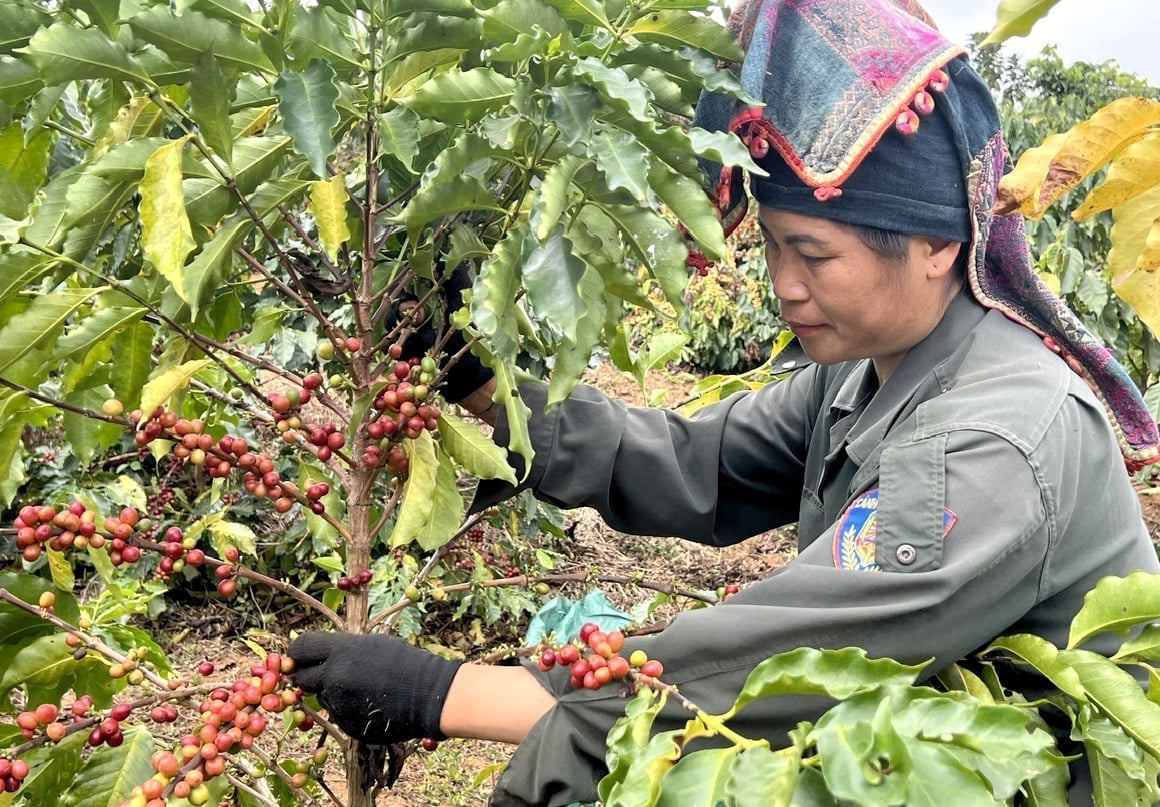November 27, 2025 | 20:31 GMT +7
November 27, 2025 | 20:31 GMT +7
Hotline: 0913.378.918
November 27, 2025 | 20:31 GMT +7
Hotline: 0913.378.918

Vietnam’s coffee exports in the first seven months reached a record of USD 6 billion. Photo: Thanh Son.
Coffee is the agricultural commodity with the most dynamic growth in exports this year. Nguyen Nam Hai, Chairman of the Vietnam Coffee-Cocoa Association (VICOFA), reported that in the first seven months, coffee exports reached USD 6 billion in value and 1.1 million tons in volume - up 7.4% in volume and 65% in value compared to the same period in 2024. Thus, in just seven months, Vietnam’s coffee export value in 2025 already surpassed the previous full-year record of USD 5.62 billion, marking the first time that Vietnamese coffee exports hit the USD 6 billion milestone.
If we consider the first ten months of the 2024/2025 crop year (from October 2024 to September 2025), Vietnam exported approximately 1.35 million tons of coffee valued at about USD 7.5 billion, a 1.1% drop in volume but a 56.6% increase in value compared to the same period in the 2023/2024 crop year. Thus, the 2024/2025 crop year is the first in which export value exceeded USD 7 billion, and could potentially break the USD 8 billion threshold by the end of the crop year on September 30, 2025.
This year’s robust coffee export growth is primarily driven by high global prices. According to Nguyen Nam Hai, in February 2025, Robusta coffee prices on the London exchange reached USD 5,800 per ton, while Arabica prices on the New York exchange hit USD 9,200 per ton.
In Vietnam itself, at certain points this year, coffee prices reached VND 135,000 per kg and now maintain levels above VND 100,000 per kg. Regarding export prices, in the first six months of 2025, the average export price of coffee reached USD 5,705 per ton, up 59% compared to the same period in 2024.
Moreover, according to the Agency for Import-Export under the Ministry of Industry and Trade, coffee enterprises in Vietnam have increased investments in processing technologies and traceability systems to enhance product value. Additionally, effective utilization of free trade agreements such as EVFTA, UKVFTA, and CPTPP has helped businesses expand export markets and improve export turnover.
Many companies have also proactively shifted to sustainable production models, emphasizing international certifications like Rainforest Alliance and Fairtrade. This not only supports higher selling prices but also reinforces brand reputation and Vietnam’s position in the global coffee supply chain.

Farmers harvest Arabica coffee in Son La. Photo: Thanh Son.
For the remainder of the year, like other agricultural sectors, the key issue for Vietnam’s coffee industry remains U.S. retaliatory tariffs. The U.S. is one of Vietnam’s largest coffee markets. In the first six months of this year, coffee exports to the U.S. amounted to 61,000 tons, worth USD 334 million, up 11% in volume and 76% in value compared to the same period in 2024.
On the U.S. market, Vietnamese coffee mainly competes with coffee from Latin American countries such as Brazil and Colombia. In light of the U.S. imposing a 50% retaliatory tariff on Brazilian imports, this creates a significant opportunity for Vietnam.
Brazil has long been the largest coffee supplier to the U.S., exporting around 400,000–500,000 tons annually (equivalent to about 8.1 million bags in 2024), but the 50% tariff on Brazilian goods will sharply increase the price of Brazilian coffee in the U.S., currently already elevated. U.S. traders are likely to seek sources with much lower tariffs, including Vietnam.
Additionally, amid continued global supply chain disruptions, Vietnam is highly rated for supply stability and improving product quality, key factors helping Vietnamese coffee maintain and expand its market share in the U.S. in the coming years.
Furthermore, according to Do Ha Nam, Chairman of Intimex Group, Vietnam holds a major advantage in exporting coffee to Europe in light of the upcoming European Union Deforestation Regulation (EUDR) scheduled to take effect January 1, 2026. As of now, among major coffee-exporting countries, Vietnam is almost alone in being ready to meet EUDR requirements. Therefore, European buyers are increasingly purchasing Vietnamese coffee to ensure compliance with EUDR.
With record export value so far and significant opportunities in the months ahead, Nguyen Nam Hai forecasts that Vietnam’s coffee exports for the full year 2025 will reach approximately 1.5 million tons with a turnover of USD 7.5 billion.
* $1 = VND 26.490 - Source: Vietcombank.
Translated by Huong Giang

(VAN) China’s cooking oil is suddenly flooding into India. It all comes down to a soybean surplus that Beijing doesn’t quite know what to do with.

(VAN) An Giang promotes supply-demand connections, standardizes quality and builds value chains, creating a foundation for sustainable bird’s nest development and aiming to expand exports.
/2025/11/24/5339-4-nongnghiep-075331.jpg)
(VAN) Recently, the conference on 'Sustainable Fisheries Linkage Chain - Tilapia for Export' took place in Tien Hai commune, Hung Yen province.
/2025/11/21/4309-2-153400_128.jpg)
(VAN) Green and low-emission rice is paving the way for Vietnamese rice to enter high-end markets, marking the beginning of a transformation journey toward greening and elevating the national rice brand.

(VAN) ‘Right to Win’ outlines a national action plan that shapes a new vision for Viet Nam’s agriculture in an era of renewal and global integration.

(VAN) Lam Dong’s farmed sturgeon output this year is expected to reach 2,300 tons, worth VND 450 billion, affirming the brand’s position on the market.

(VAN) A surge in Ukrainian egg exports, largely driven by soaring sales to the UK over the last few years, has notably pushed up egg prices on the domestic market.